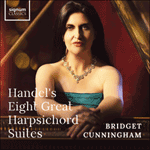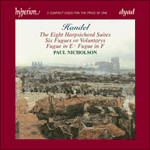Suite No 1 in A major begins with a partially written-out version of an improvised French prelude with cascades of scales and arpeggios which exploit the instrument’s resonance as an amplified, mechanically-plucked lute. The key of A major was traditionally associated with youth and spring, and potentially with energy; Charpentier called it ‘joyeux et champêtre’. The allemande is grand, opening with scales imitated in inversion. After the modulation to the dominant and the double bar, the dotted figuration is inverted. Textures are characteristically stable and sturdy, as are those of the courante, which seems to revel in the harmonic richness which accrues from the moving inner parts. In this buoyant A major suite Handel dispenses with a sarabande and moves direct to a consummatory gigue in Italian style.
from notes by Wilfrid Mellers © 1995
La
Suite no1 en la majeur débute avec une version partiellement écrite d’un Prélude français improvisé, avec une cascade de gammes et d’arpèges qui exploitent la résonance de l’instrument, comme si celui-ci était un luth amplifié dont les cordes sont pincées mécaniquement. Le ton de la majeur était traditionnellement associé à la jeunesse et au printemps, et potentiellement à l’énergie; Charpentier l’intitula joyeux et champêtre. L’Allemande est majestueuse, débutant avec des gammes imitées en inversion. Après la modulation en dominante et la double barre, l’embellissement en notes pointées est inversé. Les textures sont, de façon caractéristique, stables et solides, comme celles de la Courante, qui semble se réjouir dans la richesse harmonique provenant des parties médianes mouvantes de l’œuvre. Dans cette Suite énergique en la majeur, Hændel supprime la Sarabande et fait suivre directement une Gigue complète de simple style italien.
extrait des notes rédigées par Wilfrid Mellers © 1995
Français: Isabelle Dubois
Die
Suite Nr. 1 in A-Dur beginnt mit einer fast ausgeschriebenen Fassung eines improvisierten französischen Präludiums, die Kaskaden von Läufen und Arpeggios enthält. Diese nutzen die Resonanz des Instruments, als sei es eine verstärkte, mechanisch gezupfte Laute. Die Tonart A-Dur wurde traditionell mit der Jugend und dem Frühling assoziiert, und potentiell auch mit Energie; Charpentier nannte sie joyeux et champêtre. Die Allemande ist großartig angelegt und beginnt mit Läufen, die in ihrer Umkehrung imitiert werden. Nach der Modulation zur Dominanten und dem Doppelstrich findet eine Umkehrung der punktierten Figurierung statt. Die Strukturen sind typisch stabil und robust, und dies trifft auch auf die Courante zu, die ihre wahre Freude an der harmonischen Fülle zu haben scheint, welche aus ihrem beweglichen inneren Teil erwächst. In dieser heiteren Suite in A-Dur verzichtet Händel auf eine Sarabande und geht unmittelbar zu einer vollendeten Gigue im schlichten italienischen Stil über.
aus dem Begleittext von Wilfrid Mellers © 1995
Deutsch: Angelika Malbert





 Handel: Eight Great Harpsichord Suites
Handel: Eight Great Harpsichord Suites Handel: Harpsichord Suites
Handel: Harpsichord Suites
